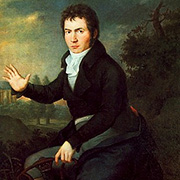As a general rule, the further we go into Beethoven’s life, the more his autograph manuscripts survive. This is only to be expected; the more famous he became, the less his manuscripts were likely to be discarded once the work was printed. But the piano concertos represent a curious exception to this rule: unexpectedly (but this time frustratingly and unfortunately) the whereabouts of the Fourth Concerto autograph remain unknown.
Every new edition of the Fourth Concerto has therefore had to base itself on two sources, both supervised by Beethoven but both in some measure unsatisfactory; there is never any adequate substitute for Beethoven’s autograph. We possess only a copyist’s score with Beethoven’s corrections, held in the Archiv der Gesellschaft der Musikfreunde, Vienna, and then just the first edition, published in parts in Vienna in 1808 and containing some minor revisions which post-date that copyist’s score. With no new information, therefore, the surprise has been to find how many markings and spurious emendations survive in all modern editions (even urtexts) which have no basis in these two authentic sources. When the full score was finally published in 1861, it contained hundreds of additional markings which have only gradually been expunged in editions published since. Many have survived, unsuspected, until the present day.
It has been satisfying, finally to strip away that last layer of dust, and return to what those original sources have genuinely handed down to us. In the first movement, at the grand return of the opening, ushered in so gloriously by the two high horns, the soloist enters immediately on the first beat with a thunderous three-octave G, which leaps up heroically to restate the main theme. This first note G has always been missing from the soloist’s part, because in that first copyist’s score the word Solo was written a little too far to the right – which implied that those G’s were perhaps merely part of the previous cue. But there is a good deal more evidence which, summoned into the equation, leaves us in no doubt that they very much belong to the soloist’s part, and greatly enhance the drama of his entry, as well as creating a felicitous and beautiful echo of this upward leap in the strings’ entry five bars later. In the slow movement, every modern score has been incorrectly printed at the mysterious moment when the piano finally casts off its gentle “una corda” veil, and speaks confidently with all its three strings (“tre corde”). This effect must not even begin to take place – nor the crescendo that accompanies it – until the third of the three trills, the one on C.
The Rondo has one unexpected note, over four bars, just before the second subject, which has hitherto always been altered, but which actually finds a close parallel in works by both Haydn and Mozart (though both have also often been adjusted editorially). We have restored what Beethoven wrote, confident that had he wanted the double sharp, he would not have omitted it in all four bars.
Jonathan Del Mar



